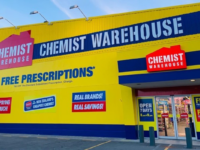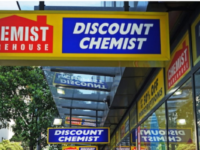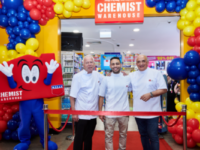What makes Chemist Warehouse so successful? Diversification and finding a strategic advantage has seen the brand increase its number of stores more than tenfold since the beginning of the millennium, and founder Jack Gance anointed as this year’s Australian EY Entrepreneur of the Year.
Jack qualified as a pharmacist in 1966 and bought his first pharmacy in partnership with his brother in 1972. Wanting to do something entrepreneurial, they decided to diversify the traditional pharmacy offering by importing sunglasses. Sourcing a list of sunglasses manufacturers from the Taiwanese Consulate whose products were less expensive than those of the multinationals, and appointing their sister as their first salesperson, they went out selling the sunglasses and it was a huge success.
Then in 1979, at a trade fair in France, Jack’s wife Evelynne saw an unbreakable, lightweight pair of sunglasses which he brought back to sample. Jack did a contra deal with an advertising agency, they created the brand Le Specs, and the business grew dramatically. Realising the potential of expanding their product range beyond sunglasses the brothers settled on suntan lotion, launching the Le Tan brand.
Product innovations Le Specs, Le Tan
“Le Tan took off like a rocket,” Jack enthuses. “And we had about 30 per cent market share in sunglasses. It was a very successful product in pharmacy and pharmacists trusted us because it was very profitable for them. And when we came out with Le Tan, they bought it sight unseen effectively.”
“If you’re going to get into a marketing fight with someone, you’ve got to have a strategic advantage.”
Capitalising on this success they were offered a perfume brand, Australis, and loved the concept, if not so much the product and its packaging. Reworking the fragrance’s formula and using renowned artist Ken Done to redesign the packaging and artwork, they relaunched the brand as a lifestyle fragrance. “It was a real breakthrough in the field,” Jack says. “People said, ‘this is not pretentious – it’s a lifestyle fragrance at a realistic price’. And that took off like a rocket as well. We developed a whole range of different fragrances, releasing a new one every year.”
They added a budget cosmetic range to their offering and by 1991 were selling more lipsticks than Revlon in pharmacies. However, concerned about a possible backlash against the French connection they had with the brand – Le Specs and Le Tan – at a time of anti-French sentiment due to that nation’s nuclear testing in the South Pacific, they accepted an offer they were made for the business that Jack describes as “too good to refuse”.
A reinvigorated return
At this time Jack “semi-retired” and did an MBA. This reinvigorated his interest in entrepreneurship and he returned to the family business, looking at it with a fresh viewpoint. “I think the biggest thing I learned from my MBA was that if you’re going to get into a marketing fight with someone, you’ve got to have a strategic advantage,” Jack says. “If you haven’t got a strategic advantage, then don’t do it. People questioned what my strategic advantage was when I started the sunglasses. Well, it was the fact that there were probably 300 people trying to sell sunglasses to pharmacy. But as a pharmacist, I went straight to the top of the queue – a pharmacist buying from a fellow pharmacist.
“When I went back to the business we had 35 stores, all with different names, which were fundamentally run by the wholesalers who did it for their benefit, not for the benefit of the retailer,” Jack explains. “They would promote products that were giving them the biggest margin, but not necessarily the biggest margin for the retailer. So, we rebranded all the stores My Chemist and we focused on the front of shop business where we had a lot more health and beauty than the average pharmacy.”
By 2000 the business had 50 stores, with the strategic advantage of that volume giving it a strong point with the suppliers alongside the fact that those stores were well run, successful operations. The business thrived and today that number of stores has grown to approximately 600. “We’ve got 500 Chemist Warehouse stores in Australia, 47 stores in New Zealand, seven stores in Ireland, five stores in China and we are the largest retailer of health and beauty products on T Mall Global (Alibaba) in China.”
Chemist Warehouse growth based on front-of-shop business
This growth is in large part down to the fact that Jack has grown his front-of-shop business to about double or triple the average pharmacy. “The average pharmacy is doing about $1 million in total business – we were doing $2 or $3 million,” Jack says. “The average pharmacy earns about 25 per cent of its revenue front-of-shop – that’s everything other than prescriptions, we do about 70 per cent front-of-shop. That’s not because we don’t do many prescriptions – we do 25 per cent of all prescriptions in Australia.”
Chemist Warehouse believes affordable health is a universal right, and strives to ensure they make that available at an affordable price to all – they discount most of their products by 25 per cent, thereby saving consumers over $1 billion a year.
Efficiency reigns
Jack stresses that the biggest costs in pharmacy and in retail are rent and wages. “If you’re paying $100,000 rent a year and you do a million dollars turnover, you’re paying 10 per cent rent,” he explains. “But if you can do $10 million with the same rent, then you’re paying one per cent rent. We go to secondary locations because we can attract people to our stores.”
With regard to wages, Jack says that you can be more efficient if you’ve got a turnover of $8 million. “You can have a more efficient operating staff – you can have one person at the checkout full-time rather than a person dusting and placing orders and putting stock away,” he explains. “There’s a lot of time wasted between the functions, so if you’ve got a person doing the stock full-time it’s much more efficient than if one person is multitasking because that wastes a lot of time on changeovers, and so on.” Operating this way means the business can offer the highest level of service without wages blowing out because the team operates so efficiently.
Jack focuses on ensuring his staff of over 20,000 employees are well trained and very motivated. Everyone in his management team has come through the ranks, starting off as students, trainees or pharmacists. “They become partners after being with us for 10 years,” Jack explains. “The culture is maintained because those people who come through learn it as they come through and then teach their students the same thing when they are in senior positions.
Strategic advantage is key to Chemist Warehouse’ growth
I think that the reason why we’re successful is because we give the consumer what they want,” Jack adds. “We give back to the consumer, and at the end of the day, it’s a win-win for everybody. I believe in win-wins – I believe if you’ve got an arrangement where one party is high-fiving and they’re really doing well, and the other party is crying because they’ve been screwed to the ground, it’s not going to work long term.”
Jack says that the bottom line is providing a win-win for everybody. “We win because we end up making a profit, you win because you’re the consumer getting a better price, and the supplier wins because we sell a lot more product and the overall sales of the category they operate in,” he avers.
Ultimately, Jack says, strategic advantage is the key to success. You may have a great idea, but if someone else has the same idea as you, what’s your advantage? “If you’ve got no advantage, find something you have an advantage in,” he concludes.
This story first appeared in issue 41 of the Inside Small Business quarterly magazine.











